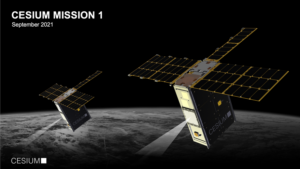“We have flight-qualified our products in-house, but the ultimate test is to get them in orbit,” Shey Sabripour, Cesium founder and CEO, told SpaceNews.
Sabripour founded Cesium in 2017 to provide plug-and-play phased array communication payloads for space and airborne applications. After years of operating in stealth mode during the firm’s initial research and development campaign, Cesium is now ramping up in-house manufacturing, testing components and shipping flight hardware to government and commercial customers.
Customers include the U.S. Navy, NASA and the U.S. Missile Defense Agency, which have awarded Cesium Small Business Innovation Research contracts. In addition, Cesium has backing from the Pentagon’s Defense Innovation Unit (DIU).
DIU is helping to fund Cesium Mission 1. As part of that mission, two six-unit cubesats are scheduled to travel to low Earth orbit in September as secondary payloads on the United Launch Alliance Atlas 5 rocket transporting the NASA-U.S. Geological Survey Landsat 9 Earth-observation satellite.
Once the cubesats are in orbit, Cesium plans to demonstrate the performance of its Ka-band active phased array, software-defined radio and single-board computer, a device about the size of a credit card. In addition, the firm plans to conduct on-orbit experiments.
Cesium is offering customers the ability to purchase time on the five-year Cesium Mission 1 to experiment with active phased array and intersatellite links. Customers have expressed interest, for example, in testing waveform switching, edge processing and communications link optimization, Sabripour said.
Austin, Texas-based Cesium established a spacecraft design facility in 2020 in Broomfield, Colorado to offer the type of “end-to-end system analysis and design” the firm plans to demonstrate in orbit, Sabripour said.
After Cesium Mission 1, Cesium’s roadmap calls for annual missions to demonstrate technologies like the Link 16 active phased array for military communications that the company developed and tested under a Navy SBIR contract. Link 16 is an encrypted radio frequency favored by the United States and NATO Allies for sharing information in military theaters.
Cesium also is working with the NASA Ames Research Center to test a compact intersatellite link communication
system designed for satellites operating in swarms.
In addition, CesiumAstro is delivering a communications system this week to the NASA Glenn Research Center as part of the SmallSat Ka-band Operations User Terminal (SKOUT) project. SKOUT is a Ka-band communications system for a NASA mission that is designed to connect government and commercial relay satellite constellations as well as direct-to-ground communications networks.



